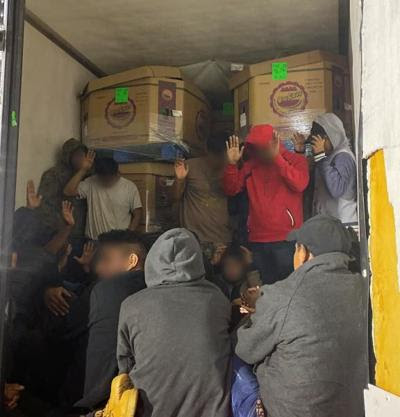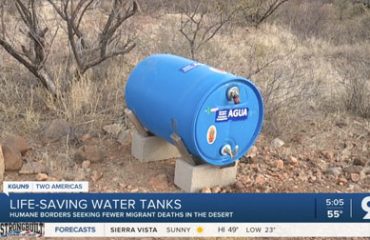January 12, 2021
By Jorge Encinas
The Office of the Medical Examiner reported a near-record breaking year for undocumented border-crosser deaths in 2020, with 220 remains recovered in Pima County. On Oct. 8, County Administrator Chuck Huckelberry reported 177 UBC remains recovered in the first three quarters of 2020, and projected 200 by year’s end. The county defines a UBC in the Medical Examiner’s annual reports as foreign nationals who cross the border without permission and die. The county began recording UBC deaths in 2000. The Medical Examiner’s Office reported the 222 UBC deaths in 2010 was the highest on record. From 2000 to 2019, the Medical Examiner recorded 3,081 UBC deaths with 1,970, 64 percent, identified. In 2019, the county identified 49 of the 153 UBC remains.
Causes of death
The Medical Examiner’s Office reported 156 of the 220 UCB remains in 2020 as undetermined causes of death. In 2019, 80 percent, 122, of UBC deaths remained undetermined causes of death. The Medical Examiner’s Office noted the remains’ conditions as a primary factor in not determining a cause of death. The 220 UCB remains in 2020 arrived predominately in skeletal form. There were 131 skeletal remains, five decomposed and 12 mummified in various states. The Medical Examiner’s Office attributed 44 deaths to probable hyperthermia – an abnormally high body temperature. Hyperthermia was the highest attributed cause of death, followed by 10 blunt force cases. Four UCBs – including three from Dec. 28-30 – remain pending.
In October, Huckelberry attributed 2020’s UCB increase to record-breaking summer heat. On Wednesday, Huckelberry said he planned to reach out to Tucson-based Humane Borders – a non-profit group providing water stations in the desert for border crossers. The group also has a map marking the location UBCs were recovered using data from Pima and Maricopa Counties’ medical examiner data. “What I’m going to do is write to and ask Humane Borders, which is the folks who do a lot of the rescues associated with folks stranded in the desert, to take a look at it and give some recommendations on what they think we can do to reduce the number of border crosser deaths,” he said. “Pull in with the NGOs, we’ll see what federal policy brings with the new administration. But at this point, I’d rather have the opinion and expertise of the NGOs who’ve been dealing with this problem for some time.” The Medical Examiner’s Office reported receiving 13 UBCs in June, 25 in July, 25 in August, 35 in September and 16 in October. The National Weather Service in Tucson reported multiple heat records broken during the summer. Tucson recorded 108 triple-digit days – the most in a single year. September also marked the three consecutive hottest months on record. Precipitation remained below average with a lackluster monsoon season as well. Chief Medical Examiner Dr. Gregory Hess said about half the remains are found by U.S. Border Patrol agents and the other half are found by NGOs, recreationists, hunters and ranchers.
Santa Cruz County
Santa Cruz County also saw a big increase in deaths in 2020. Data provided by the Sheriff’s Office shows calls related to undocumented foreign nationals increasing over the past three years, with a sharp jump occurring in 2020. The number of migrants found dead in the county also spiked during the past year, according to records kept by a humanitarian organization working in partnership with the Pima County Medical Examiner’s Office. In 2018, the Sheriff’s Office reported six search-and-rescue (SAR) missions and 105 referrals, the latter number representing undocumented migrants who were apprehended and referred to the Border Patrol. The following year, those numbers jumped to 17 SAR missions and 128 referrals. As of Dec. 19, the Sheriff’s Office had conducted three times as many SAR missions in 2020, for a total of 51. Referrals showed a similar increase, rising to 355 in continuance of a trend reported on by the Nogales International in August.
An interactive map published by the Tucson-based nonprofit Humane Borders, which provides aid for migrants in the desert, showed 14 migrant deaths reported in Santa Cruz County as of Dec. 30. That was the highest number of migrant deaths since 2011, when the organization reported a total of 18 bodies found in the county. It was also well more than the three deaths reported in 2019.
Of the 14 deaths confirmed in 2020, only one had possibly occurred the previous year; skeletal remains that were found in July about a mile west of Nogales showed six- to eight-month ecomposition. In seven cases, the medical examiner listed the cause of death as hyperthermia or probable hyperthermia – excessive body temperature, usually caused by the weather. Another five had an undetermined cause of death due to the condition of the bodies. One was a young woman who was crushed by a train in Nogales in March, and another, a 25-year-old man, died of multiple gunshot wounds from a Border Patrol agent in September, reportedly after stabbing the agent. All of the bodies or remains were recovered from March through October.



